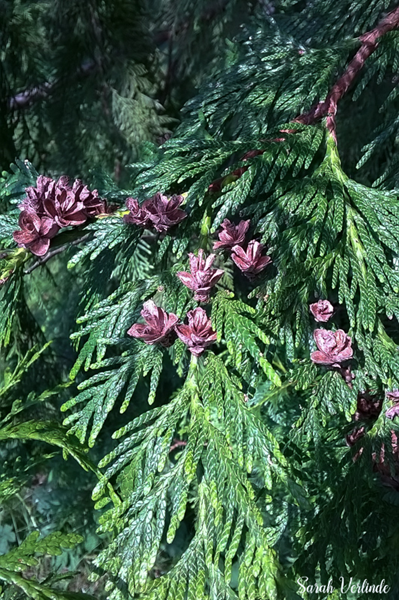Western redcedar
Thuja plicata – Western redcedar

At a Glance:
- Family: Cupressaceae
- Plant Type: evergreen tree
- Distribution: Mostly Pacific Coast, California to Alaska, as far east as Montana
- Habitat: Moist (rainy) areas and wetlands
- Height: about 200 feet
- Cones: male and female cones. Male cones are 2mm long and round, soft and brown to yellow. Female cones are 8-10mm long and slightly oval in shape with a woody texture.
- Cone Season: form in April-May
- Leaves: slender and dropping, leather-like, flattened and scale-like
- Generation: Perennial
- Bark: reddish-brown, vertically
Restoration and Conservation
Saplings provide a major food source for deer and elk during fall, winter, and early spring. Mature tree stands provide shelter for many animals. In the empty cavities or old trunks, den dwelling animals like bears, skunks, and raccoons will take up residence. Many birds will use the tall branches or cavities from fallen branches to make nests in. Western redcedar provides plenty of space and resources to support plenty of biodiversity including insect species, fungi, rare ferns, and lichen.
Ethnobotany and Plant Uses
Western redcedar is a very valuable plant for its cultural and commercial value. The wood is resistant to decay and makes an excellent material to make shingles, siding, furniture, fence poles, canoes and boats, and wood pulp/chips. Native American tribes have relied on this plant heavily, often calling it the “tree of life”. Northwest coastal tribes used the wood for shelters, canoes, and firewood. Its inner bark could be woven into baskets or finely pounded into a fiber that was used for making clothes or used to line diapers.
The natural plant extracts of the leaves are fragrant and powerful. They are extracted and used in perfumes, insecticides, soaps, and shoe polishes. The extracts are even used in the process of refining lead. The wood is used inside of closets to repel moths and spare clothes from insect pests. It is also an important plant for landscape use and the leaves are used as a floral crop for foliage.
References and Resources
- FEIS/USDA: https://www.fs.fed.us/database/feis/plants/tree/thupli/all.html
- WTU Image Herbarium: http://biology.burke.washington.edu/herbarium/imagecollection/taxon.php?Taxon=Thuja%20plicata
This article was written by Sarah Verlinde. For questions regarding the UWB/CC Plant Tour, contact Sarah at severlin@uw.edu.